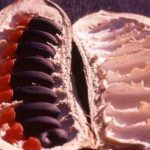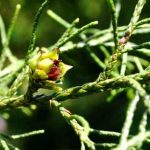TREE LIFE
JUNE 1992
MASHONALAND CALENDAR
Saturday, 6th June : Botanic Garden walk. Please not the switch to Saturday during winter. During the cold months Tom will take us around the gardens on Saturday mornings at 10.45 for ll am. As before we may park at the Herbarium.
Please note the switch to Saturday
Sunday 21st June : Mr and Mrs J Danckwerts have again kindly agreed to be our hosts this month. Our last visit to Chedgelow Farm was in July 1989 when we were just too late to witness the wonderful sight of hundreds of flowering Aloe chabaudii. Dare we hope for better luck in this very confusing (for the plants) drought year. The woodland and granite outcrops also hold such delights as Dalbergia nitidula, Pappea capensis, Ficus verruculosa and Cordia sinensis. Interested ?
Saturday 27th June: Walk with Mark in the Mukuvisi Woodlands — meeting in the main car park at 5 pm.
Saturday 4th July: Botanic Garden Walk
MATABELAND CALENDAR
Sunday 7th June 1992 : We had such a welcome last time, at Mike and Trish Wood’s Glencurragh Farm, out on (and beyond) Nyamandhlovu Road, that we have been looking forward to a repeat — but this time on the north—east and of the farm. All day, meet 8.30 am at the Blake’s home to sort out transport or at the Falls Road Motors. Bring teatime/lunch/chairs. Sesamothamnus lugardii here we come .
Wednesday 17th June 1992 : McHEW at Hillside Dams at 5pm
Sunday 5th July 1992 : Back to Mguza Nature Reserve, but to a completely different area on the quartz ridge, with beautiful views over the well treed countryside. Morning only – meet at Falls Road Motors, as it is only 15 km from Bulawayo. Bring teatime, chairs and your 31 entrance fee – and stand by for a good morning!
A TALE OF TWO CITIES AND AN ANCIENT VOLCANO : APRIL 1992
Next time you visit the exciting SUN CITY in Bophutatswana forget the fleshpots and spare a day, or better still a few days, to enter into an equally exciting world of unique geological formations, cone-shaped hills, sweeping plains, a vast diversity of vegetation and herds of wild animals. In the quiet setting of an ancient volcano, but a short distance from Sun City, where the outer wall of lava forms a natural scenic barrier which screens Pilansberg National Park from the outside world, one can only absorb a small portion of its uniqueness in a single day. As Sun City reflects the hand of man in its exotic gardens, glorious lawns, artificial lakes and waterfalls, bedecked with crested cranes, flamingoes and black swans, and in the busy helicopter pads and incessant slot machines, so this Park reflects the vast hand of nature now wisely preserved and unspoilt by man.
Man has been busy again and one cannot fail to notice rising behind Sun City on an arid bushveld hill six dramatic towers of exquisite design, reminiscent of ‘minarets‘ beneath which will be a luxury hotel. An interesting article appeared in the local newspaper from which I quote — “Mixed feelings is perhaps an appropriate designation what members and friends of the Olienhout branch of the Dendrological Society experienced on Saturday 21st March as they looked down on the prospect from an eminence near Bakubung Gate at Pilansberg where, emerging from the arid bushveld landscape, their gaze encountered the splendid and barbaric outline of that edifice called the LOST CITY. Evoking the Africa of Rider Haggard and Edgar Rice Boroughs ‘. . . . . here was the latest expression conforming the Herodotus‘ dictum “out of Africa always something new”. However, the tour leader soon had all participants back on terra firma again with matter of fact information relating to the forced removal of centuries old baobab trees, establishment of rain-forests and reptilian swamp habitats cheek—by-jowl with desert landscapes and related arboricultural matters. Traversing the extensive nurseries on the site soon banished any feelings of unease that might have remained. It was certainly unusual to use a fully grown Burkea africana transplanted from a site hundreds of kilometres away, apparently without any effect. Other trees like Ochna pulchra and Boscia foetida were less fortunate. A photograph of a very large baobab is tangible evidence of the success achieved in transplanting fully grown indigenous trees.
Leaving this bizarre landscape it is a pleasure to enter the quietness of the National Park through one of the two entrance gates. The gate attendant may have a bird and a tree check list which will be of help in identifying both. The Park itself covers a total area of 500 square kilometres and the Pilansberg volcano area is 25km across. This does make it one of the largest volcanoes of its kind ever formed anywhere on earth. There is a good network of roads traversing the area, but at the gate you will be given a map enabling you to find your way with ease to the very centre, Mankwe Lake, which was the central and main conduit for lava which erupted so many million years ago. What makes it so interesting geologically is that many or the lavas have been eroded over the space of time and form a semi-continuous ring all around the heart of the volcano resulting in rings of hills each one a separate pulse of lava; in other words the geologists are now able to examine the rocks deep down inside the crater. Close to Mankwe is the Pilansberg Centre, which is the old Magistrate’s Court an interesting building converted into a tourist cum tearoom centre and more particularly there is a scale model of the Park with small lights which will pin point points of interest. This allows you to get a good idea of the topography and here, too, you can pick up a booklet on the geology detailing localities of great interest. How else would I have known that the: two cone hills by the shining red in the sunlight were actually red syenite (the colour caused by very finely disseminated iron hydroxide minerals) or that the great slab of green/pink/purple rock finely pitted with small holes was green foyaite. Whether it is neat blocks of rock piled on each other or merely a jumble of rocks tumbling everywhere the hills are well wooded and literally festooned with “dassies lapping up the morning sunlight.
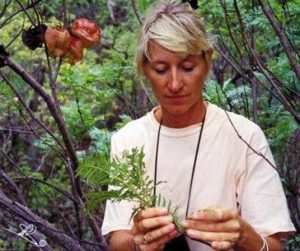
Erythrophysa transvaalensis (Transvaal red balloon tree). Photo: Richard Peek. Source: Flora of Zimbabwe
At one locality grows the rare Erythrophysa transvaalensis (Transvaal red balloon tree) on the rocks!
The first impression one has is that there is nothing but Acacia here, a sea of black branches green leaves and white thorns crestecl with gold (Acacia karoo at its best). It then becomes apparent that in the dense bush there many and varied trees but none are very large; they are not the giants we see here and as the soil type varies from rich clay to sandy loam so the various species become predominant. In one area even the Euphorbia ingens (candelabra tree) is king and there is a hill peppered with Aloe marlothii_ (the flat-flowered aloe) and what a sight this will be in flowering season. But the Acacia is every where ; Acacia caffra, A.erioloba (what vicious thorns), A.mellifera, A.nigrescens (conspicuously knobbly prickles). A.tortillis at this time glorious with long branches of densely packed leaves and creamy yellow balls and of course tell tale corkscrew spiral pods from last year, and A.nilotica dripping strings of beads, to mention but a few. Down by the Lake there are in abundance the Olea europeae (wild olive) and the Buddleia saligna (false olive), Ziziphus mucronata, Rhus lancea and R.leptodictya, Dichrostachys cinerea, the Carissa bispinosa var bispinosa (referred to as “num-num”) and so on. Small cottages and safari tents are completely hidden from view in the denseness of the trees and scrub and are not intrusive, as are the hides in other parts of the Park. There is ample opportunity to study and identify the trees at all the picnic spots and comp sights. To add to the interest the Bophuthatswana Parks have introduced animals of every species and where the bush opens out into flat grasslands or open valleys herds of red hartebeest and sable graze whilst the heads of giraffe can clearly be seen over the tops of the Acacia in this their special feeding paradise. The family of white rhino prefer the dense bush; this is one of the two areas in South Africa where they may be seen. In the evening when the sun finally sinks into the Lake and the hippo converse in raucous tones it is quite frightening to think back on the time when this peaceful place was born of violent turmoil and fire.
-VdeVSeibert
BOTANIC GARDEN WALK MAY 1992
This month’s walk was a rush about the Rhus, in an attempt to see them all before darkness fell. Tom has at least ll of the 15 indigenous Rhus species growing in the gardens and they cover a whole range of habitats.
Rhus belong to the family ANACARDIACEAE which includes in its Zimbabwe genera Sclerocarya (marula), Lannea and Ozoroa. This family also contains some important exotics like Mangifera indica (mango), Anacardium occidentale (cashew) and the pistachio nut, as well as the widely planted garden ornamentals Schinus molle (pepper tree) and Schinus terebinthi-foluis (Brazilian pepper).
All the indigenous Rhus species are trifoliate and the crushed leaves are generally aromatic. R.vulgaris has formed a large bush in the Eastern district section. Most of us would have simply dismissed it as a slightly odd looking R.longipes. Nearby was R.dentata aptly named with its very toothed leaf margins, quite unlike any Rhus we see near Harare. It inhabits the Eastern Districts, and the central areas in riverine forest.
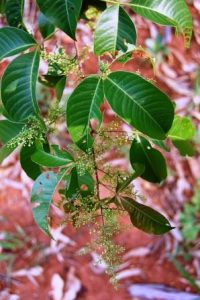
Rhus chirindensis. Photo: Stefaan Dondeyne. Source: Flora of Zimbabwe
R.chirindensis overlaps the distribution of R.dentata but the leaf is so different that there is no chance of muddling them. T.chirindensis has a very long petiole, the leaflet margins which are entire are very tapering and end in a hairlike tip. This species often forms a liane.
R.tumulicola (formerly culminum) is another species of limited distribution in high altitude evergreen forest, but is easily distinguished for the two previous species by it’s rounded entire leaflets.
R.tomentosa is common near the path up Mount Inyangani where it forms small shrubs.
It has semi dentate leaflet margins but a very distinctive white underside to the leaflets unlike any other Rhus we have seen.
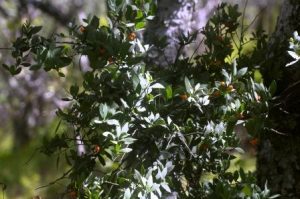
Osyris lanceolata. Photo: Bart Wursten. Source: Flora of Zimbabwe
On the way to another vegetation area we passed Osyris lanceolata (SANTALACEAE “sandalwood” family) which Tom is pleased to have managed to introduce to the gardens, as it is now known to be a partial parasite on tree roots (No mention of this in the 1977 – published Coates-Palgrave).
R.leptodictya is a species of the granite outcrops and open woodland – its leaf form resembling R.lancea, leaflets being very narrow, but the margins of R.leptodictya leaves are finely serrate, those of R.lancea entire.
And so we passed on to R.natalensis which is now memorable as Tom’s “lovers tree”, so called because its ever green nature and very dense growth form makes it a favourite site for a romantic rendevous. It forms dense or scrambling bushes at forest margins. Tom explained that this species may be incorporated into R. gueinzii. We then went off to the South East Lowveld section to see R.geomzii var spinescens, the spiny Rhus. We all agreed that there was very little resemblance between this and R.natalensis, but for some academic reason the experts may deem the present two species varieties the same species. Tom did explain that the whole genus is in a state of change.
With darkness and cold descending we looked in vain for R.tenuipes which occurs mainly on the great Dyke, and then found R.lucida a very distinctive plant of the Eastern Districts dry forest. Its very small leaves are waxy and tend to crack when bent.
We left out our most commonly encountered Rhus species on this walk, Rhus longipes, R.quartiniana etc, but we thank Tom for introducing us to some of the less common ones.
-Cheryl Haxen
FOSSICKING AT GOODHOPE CLUB
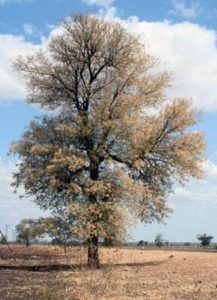
Acacia nigrescens. Photo: Petra Ballings. Source: Flora of Zimbabwe
After a leisurely lunch (including ants of a somewhat peppery nature) under an Acacia nigrescens and its strangler fig Ficus thoningii is was time for a “walk about”.
Descending from a smart new Landcruiser brought us into easy reach of a Cassia abbreviata which had kindly kept a few pods for easy identification. Very well armed Acacia karoo encouraged us to keep our distance from the healthy spines. Ziziphus mucronata occurred in large numbers and despite care being taken; shorts and skin received some damage. Deeper into the roadside bush Cassine transvaalensis occurred in various shapes and sizes, Commiphora mollis obligingly having kept a few leaves and Peltophorum africanum despite its small size was an excellent flywhisk against a pair of armoying little . . . .! Not surprising in bush full of Colophospermum mopane.
This area must be a riot of colour in summer with large numbers of mature Bolusanthus speciosus but Combretum molle was suffering the effects of drought by displaying shrivelled leaves. Arboreal fog descended when Balanites aegxptiaca and Ximenia caffra were growing close together. At first glances it was difficult to tell the darn things apart, however, Maureen and Fiona were at hand to assist. Well fruited Terminalia sericea occurred frequently and provided easy identification. Euphorbia ingens was noticed in groups but not in the some quantity as Bolusanthus speciosus.
Maytenus heterophylla was noticed and so were its standard “nasties” on the stems. As the afternoon lengthened cranial activity slowed so Grewia flavescens and G.monticola,
Ozora insignia and Pavetta gardeniifolia failed to make much impression. On the return to the road Cassine matabelica caused a short delay whilst its merits were discussed.
Further away from the camp area the Rhus family appeared, namely R.lancea and R.tenuinervis (turn me nervous), Senna singueana and Albizia harveyi (don’t ask me to identify it) were also in the vicinity of a dried up stream. Scrubby Dalbergia meloxylon, Combretum imberbe and Flueggea virosa were apparent further up the slope. On rougher ground the Commiphoras came into their own, C.africana and C.schimperi were subjected to some low tech surgery to establish their identity.
After some liquid refreshment enabled us to continue to examine a strange, leafless copper coloured stem was discovered. Some surgery was performed and its Euphorbia tendencies were noticed but only in the evening did Ian give us the answer as E.espinosa.
Many thanks to the group for help in “Fog” clearing and to Karl for transport and refreshments .
-Andy MacNaughtan
GOODHOPE/GWAMPA/EMBUKHISWENI WEEKEND – 30th April — 3rd May.
There were 20 of us, six from Bulawayo and fourteen from Harare. On Thursday, we arrived at Goodhope Country Club (near Turk Mine) at various times, and got settled in. Some members were camping, and the rest of us were accommodated in two “dormitories”.
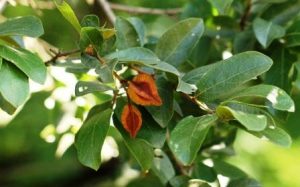
Combretum hereroense . Photo: Bart Wursten. Source: Flora of Zimbabwe
We strolled off in small groups to explore our surroundings. Some of us went down a path to a dam. Acacia rehmanniana and A.karroo were growing side by side, providing a good opportunity for comparison. Combretum hereroense was putting on a beautiful display of masses of russet-coloured, golden edged fruits. Ozoro insignis was also fruiting, producing large numbers of greenish-mauve immature “berries”.
The following morning, we set off for the Gwampa Forest Reserve. This was a “four-wheel drive excursion”, so we sorted ourselves into the four available vehicles. From the back of a truck, we had good views of the trees around us. Areas dominated by Colophospermum mopane alternated with Acacia country. Among the several species of Acacia, were some beautiful, big specimens of A.nigrescens with enormous “knobs”, and A. polyacantha in a river valley. Terminalia sericea and T.randii were both present. We admired Combretum imberbe and Maerua angolensis.
We also had the thrill of seeing about 300 vultures circling overhead. We stopped the vehicles, and Ken Blake and Andrew MacNaughtan went to investigate. They reported that the birds were being attracted to about ten cattle carcasses. They were mostly white backed vultures, with a few lappet-faced ones, and one Cape vulture. There were also three Marabou storks and numerous crows.
When we arrived at the Forest Reserve, we found that only a small part of the area we visited agreed with one’s mental picture of a “forest”. This part consisted of large Baikiaea plurijuga trees dominating an open, park-like region. Most of the Reserve was miombo woodland, containing a tremendous variety of trees and shrubs. To some of the Hararians present, there were several species that were unfamiliar, being characteristic of medium to low altitudes or Kalahari sand. These included, Bauhinia tomentosa, Baphia massaiensis, Grewia retinervis and Lonohocarpus nelsii. One of the most interesting was Erythrophleum africanum, the “ordeal tree”.
There were also many “old friends”, including large trees such as Brachystegia spiciformis, Burkea africana, Combretum molle and Parinari curatellifolia and shrubs and small trees such as Grewia monticola, Dichrostachys cinerea, Senna singueana and Gardenia volkensii.
We had a most enjoyable time wandering through the Reserve. Then the “B team” had a fairly uninterrupted drive back to Goodhope, but the “A team” kept stopping to investigate more and more interesting finds. One of these was Schrebera trichoclada, which was only identified after Robert Battersby produced the characteristic “wooden pear” fruit. On Saturday morning, we set off for Tom Goddard’s ranch, Embulchisweni, near the junction of the Shangani/Umsangwe rivers. We travelled along the “Old Hunters‘ Road now a good gravel highway, very different from what it must have been in the 1800’s. We had a good view of the Mambo Hills on our right. Mostly, we travelled through Brachystegia country, with both B.spicifomis and B.boehmii. There were a few specimens of Adansonia digitata, and Burkea africana gave lovely splashes of golden, autumn colour. ‘
On our arrival at the ranch we had a warm welcome from Tom and Salie Goddard, who showed us over their newly-built home which blends into the landscape on an “impossible site” on top of a kopjie and partly incorporates the kopjie boulders in its walls in a manner reminiscent of Great Zimbabwe. It is a quite fantastic place; an architectural and engineering masterpiece built of local stone, wood and thatch, judiciously supplemented by concrete and steel. We were told that “Embukhisweni” means “the place with a view”. There are superb views from all the rooms, including the loo.
After very welcome tea and biscuits, we strolled down the kopje with its Combretum molle and Commiphora marlothii trees, through woodland to the Shangani river. Some of the woodland trees were Combretum apiculatum, Peltophorum africanum, Pterocarpus rotundifolia and Sclerocarya birrea, while the shrubs included Carissa edulis, Pavetta schumanniana, Ehretia rigida, Maytenus senegalensis and many other species.
At the river, we came across a beautiful Ficus abutilifolia tree, with enormous leaves. Other large trees in the riverine area included Acacia galpinii, Combretum erythrophyllum and Lonchocarpus capassa. Also present were Grewia bicolor and G.flavescens, Rhus lancea, Ziziphus mucronata, Euclea divinorum, Clerodendrum glabrum and others.
We then returned to the cars and visited the new ARDA dam on the Shangani river. A grove of Acacia karoo trees provided welcome shade for lunch, which we ate looking over the white plumes of flowering Phragmites reeds to the tranquil water beyond. We then visited another dam before returning to Goodhope.
On our final morning, we paid a visit to a kopje on Dennis Streak’s farm, close to the Goodhope Country Club. It was a most attractive kopje , with well-treed sides, granite outcrops and park-like plateau dominated by large Brachystegia spiciformis trees. Julbernardia globiflora was present, and so were Erythrina latissima and Euphorbia ingens. There were three species of Ficus : F.glumosa.,, F.thonningii and F.abutilifolia; two species of Pterocarpus, P. angolensis and P. rotundifolia, and three species of Combretum : C.apiculatum, C.molle and C.hereroense. The shrubs and small trees included Croton gratissimus, with its smooth silvery leaf under- surfaces’; Cussonia natalensis with its unusual simple deeply five-“lobed leaves; and many other species.
Then we returned to the cars, bade our farewells, and want our separate ways, after a most enjoyable long week-end. We would like to thank Dennis and Gail Streak and the Goodhope country club, and Tom and Salie Goddard, for all their hospitality; and also Ken Blake and the Bulawayo section, and Maureen Silva-Jones, for their very efficient organisation of the week-end.
-Shirley Dams.
Our apologies to Ken for messing up the plans he’d so carefully made.
SATURDAY 2 MAY : THE SPLINTER GROUP
It had been agreed the night before by one and all that our objectives would include a sampling of trees in the three quarter degree squares we would cover the next day, that we would head directly for Embukiswene (it was by no means certain that our hosts would be in, and if not we were to make ourselves quite at home); do our botanizing on the way back to the base at Good Hope Country Club and that if time allowed, a visit to the Mambo Hills would be squeezed in. But “the finest plans have always been spoilt by the littleness of them that carry them out. Even emperors can’t do it all by themselves” (Bertold Brecht).
Perhaps we should have sensed that be leaving early to inspect a Euphorbia espinosa near the grid that an irreversible attrition had already set in. We pottered there for ten minutes confirming the Euphorbia by its lustrous purple bronze bark (not olive green as in CP) and the main party passed us.
The left turn immediately after the bridge at Inyati took us, not as we had hoped onto the Old Hunters road, but on a twenty minute tour of the Township. Karl van Laerens‘ map sense eventually prevaled, Old Hunters Road was found and we set off at a spanking pace on this excellent gravel byway.
An assemblage of acacias on the north bank of the Longwe was quite irresistible so we stopped. It was not long before Fiona Dawe had marked seven on her card, Acacia galpinii, A.gerrardii (grey Velvet tips)! A. arenaria (mulit stemmed shrub llke with large leaves, straight pink thorns and slender sickle shaped pods). Acacia fleckii (small leaves, yellow papery bark, paired purple hooks), A.nilotica (small leaves, straight paired thorns tending to point down-stem, dark rough anastomosed bark) and very conveniently growing side-by-side, A.robusta subs robusta and A.karroo (the former‘s large sturdy leaf and the latters sickle-like pod helped our identification.) Away from the river Cadaba termitaria and Terminalia randii were interesting discoveries and Maureen Silva-Jones showed us the silver scales on the small Cadaba leaves (much smaller than the C-P drawing).
Further down the road a majestic Afzelia quanzensis brought our convoy (the Hydes had joined us at the Longwe River) to a halt. At its foot Carissa bispinosa var bispinosa with its “cross-roads” branching system and small round leathery leaves showed us how different it was from its simple—spined cousin. After this a veritable treasure trail of botanical gems led us from one exciting find to another: three species of Gardenia: G.ternifolia, G.resiniflua and G.volkenskii, Catunaregam spinosa, Acacia goetzii subs goetaii (purple pod and obovate leaflet), Lannea schweinfurthii var stuhlmannii (the false Marula, an absent petiolule distinguishes it from the real thing and a crushed leaf gives a spicy gingery small), Commiphora mollis and C.africana (identified. with red and green bark slashes as they were leafless), C.mossambicensii and most exciting of all a Zanthoxylum chalybeum of monstrous proportions. Its main stem was every bit of 30 cm in diameter with characteristic lines of nobby thorns . Before crushing the leaf for its citrus aroma we saw against the sunlight the pellucid glands scattered across the entire surface Zanthoxylum capense has them only on the margins).
A wrong turn and three stops accounted for the better part of two hours so we arrived at Embukisweni (it means a place with a view) well after the others. To our embarrassment the Goddards WERE at home. Salie responded graciously to our profound apologies by saying that she was jolly pleased that we did not all come at once as she would not have had enough cups to go round. While tea was in the making we were taken on a wonderful tour of their hill-hugging thatch and granite eyrie. Ken had already suggested that as we had been operating rather independently we should continue to go our own way.
It was an offer we could not refuse and so the two groups parted company. After tea Tom (a very busy man) with such characteristic Goddard generosity and pride in his land took us off to see a baobab on the northern boundary of the farm. It was a grand specimen some 36 metres in circumference. We had a lengthy conversation on veld management, stocking regimes and fire, under its towering branches and inspected some carved dates, one being for 1911.
Lunch was taken in miombo woodland facing each other seated on a square of few cushions and for pudding Robert Hyde kindly shared his zoo biscuits with us. Afterwards we headed for the Shangani Weir and on Mark’s instruction looked for Acacia nigrescens so far unrecorded for the central region in the Flora-Zambesiaca on the north bank of the Shangani. As the Irish law would have it there was one on the south embankment of the weir but nothing across the river. But we did find Acacia sieberiana and a Ficus glumosa amongst other things.
It was dark when we got back and as the braais were already burning we decided to cook immediately. The conviviality of the evening was enhanced by some excellent wines and after dinner Mark Hyde and Karl van Laeren brought out the specimens they had collected. Ken Blake was to have shown us his stamps but went star gazing instead.
-Ian Mccausland
SOME EXCITING FINDS – APRIL 25th — May 31
Rhamnus staddo A “pit stop” at a rocky lay-by on the Harare/Masvingo road was where we found this mystery bush. It had so many distinctive characteristics, but still defied identification. The small, simple, oval leaves on very short side branches were notched and had sparse, but definite teeth on each. The petioles were slender and the small, yellow/green fruits (unripe) were 3-lobed. This latter was a stumbling block as a hunt through Coates Palgrave had us passing over Rhamnus species several times as the description of the fruit given is “berry like, ovoid to circular” – no mention of lobes. It was identified later by Bob Drummond, and a subsequent consultation of Flora Zambesiaca showed a beautiful drawing of a tri-locular Rhamnus fruit looking exactly as we saw it. Coates Palgrave says this is a rare tree south of the Zambezi and a look at the map shows that we met it at the south—westerly tip of its small, tongue-shaped distribution in Zimbabwe.
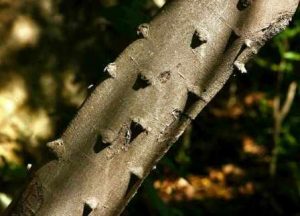
Zanthoxylem capense. Photo: Bart Wursten. Source: Flora of Zimbabwe
Zanthoxylem capense . At the some stop, was interesting in itself with a very strong lemon RUTACEAE smell and “see through” gland dots around the serrated leaflet margins, however interest was heightened when later in the week at Turk Mine/Gwampa it could be compared with Z.chalybeum in which the glands were scattered throughout the leaf-lets, resulting in a very holey appearance when held to the light. Beware enthusiastic pickers however, one can be spiked by the hostile prickles along the leaf rachis.
Across to the Matopos now and for Harare people – great delights.
Strychnos matopensis – an endemic species; a scrambler forming dense thickets of slender, unarmed branches bearing small, fresh green and shiny leaves with the typical Strychnos; “three from the base“ venation. Very distinctive features were the curled tendrils (modified branchlets?) and the small (1 cm) oval orange fruits borne in a halo over the whole mass.
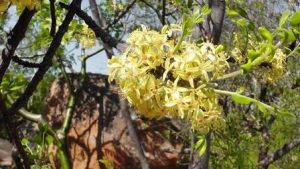
Ptaeroxylon obliquum. Photo: Bryan Orford. Source: Flora of Zimbabwe
Ptaeroxylon obliquum (Sneezewood) – the leaflet shape of this paripinnate leaf is quite distinctive, looking like a meat-cleaver similar to the identification feature of the tsetse fly (Glossina sp) – a hatchet shape in the wing venation. The overall impression, as one looks up through the canopy is of delicate airiness, helped by the very pale, grey, smooth bark. There were many of these trees on the walk down to Maleme Dam from the Eagle Lodges. Again Flora Zambesiaca has a lovely drawing of its fruit (small castanets), and the information that it is a very hard wood, practically imperishable, and when used as machine bearings will outlast iron or brass. It is, however, difficult to work and the sawdust causes violent sneezing.
Ochna glauca — another Matopos and south of Bulawayo species; a small shrub in the rocks with small, finely serrated blue—green-grey leaves (Gk glaukos grey-green; see too Brachystegia glaucescens) . Maytenus heterophylla subsp. puberula – confined to the Matopos and south of Bulawayo.
A shrub with really tiny leaves and, in young specimens, with ‘them much longer than them – a browsing deterrent if ever there was one.
Turraea fischeri — confined to the Matopos. Smooth leaved and without the puckered “draw string” effect of T.nilotica.
Turraea obtusifolia – a deciduous shrub bearing small leaves with square “shoulders”. Both species had unripe, green fruit looking like miniature deeply ribbed pumpkins, those of Turraea obtusifolia about half the size of T.fischeri.
Turraea floribunda – this was a mystery tree at Kyle near the National Parks Reception Office. About 3 metres tall with alternate, simple, lanceolate leaves not more than 5 cms long with prominent veining below and depressed veining above, giving them a quilted and puckered appearance. (Identified by Bob Drummond).
Schrebera trichoclada – a puzzling find at Gwampa Forest Reserve looked at first like a Combretum with typical opposite, simple leaves, and a Combretum look to it although not quite right. A specimen was taken for later identification, but when a member produced a very old fruit he had found beneath it, we returned and there they were – lots of yawning hippos.
One of the wise sayings of that particular outing I have taken to heart . “For every mistake one makes through ignorance, One makes a hundred more by not looking.”
-Fiona Dawes
NYARUPINDA CATCHMENT – April/May 1992
The Scene – Untimely flowers : Pink jacaranda – Stereospermum kunthianum is in full flower on the Kopje, as well as Acacia sieberiana — watch out for others.
Officially the rains begin in November and last until the end of March, Tinto recorded 424mm for the season. Two l2mm showers on April 24th and 29th temporarily freshened the parched countryside, rain glistened on the colourful mosaic of newly shed leaves, unusual for April. The lowest temperature for many months l2 degrees Celsius occurred on May Day when we awoke to a Kano Japanese landscape, mist filled the Nyarupinda valley, summits of kopjes were just visible above it. The next day a Bearded woodpecker paid us a compliment by coming to drum and tap in the tall trees near the pool. Before sundown at the dam fish jumped and the Giant Kingfisher watches and dives from a dead bamboo on a temite mound island, he dines on the shore nearby. Today May 11th there is cloud over the Great Dyke and a winter wind whistles intermittently.
There were rewards beyond expectation when we began to collect grasses, this is an on going exercise to link some of them to the occurrence of a certain species of tree, this adds another dimension to tree walks. It sounds daunting so begin with a grass mentioned in the NRB handbook called “Common Veld Grasses of Rhodesia”. Unfortunately this is out of print but older members of the Tree Society may be prepared to lend their copy, to someone interested in this project, let us hope it will catch on.
The writer quite by chance was able to recognize a blue grass which has an unusually brittle tall stem (culm) pink and waxy. Its hairless blue green leaves have rounded bases which overlap around the stem. The inflorescence consists of two racemes only, in which may florets (spikilets) each have one main bristle (awn) stout and twisted, we found this grass in seasonly wet soil where Parinari curatellifolia and Acacia gerrardii occur on the edge of a vlei. It is probably broad-leaved Blue Grass called Diheteropogen amplectens, it snaps of easily when picked unlike many others which draw blood. The handbook states that this species of blue grass is common on sandveld and easily recognised. Specimens of grasses are being collected from alluvium along the Nyarupinda stream, stoney hillsides and sandveld vleis. Waste or disturbed land may yield a larger number of different species as compared with any one of the above mentioned habitats.
Vleis The words vlei or dambo are evocative _. . . wild life diving for cover or quietly feeding among the trees along its margin; the settler farmer of yester year who threw a ‘stompie‘ out of the Chev vanette to burn the fireguard; driving through clouds of pollen at sundown; fireflies; a floating light said to come out of a hole in a vlei, Jack O’lantern, Ignis fatuus, marsh gas burning like a candle flame but much larger moving, bream crossing the road in the vlei between here and Katwa.
The Genesis of a Vlei An interesting point for those of you who have a time-scale type of mind is that vleis were probably formed several million years ago during the Pleistocene (new age) era at the close of the fourth or Gamblian Fluvial (Gamble’s fam in Kenya was where lake deposits of this era were first investigated). The climate gradually became drier end 1akes got smaller and large rivers dropped their load of silt forming thick deposits of alluvium eg in the Save valley. In drier times ahead, winds redistributed the sand. There were earth movements during the Pleistocene which tilted the land surface in this part of Africa and cycles of erosion since then have made the landscape much as it is today. This simplification provides a basis for understanding how vleis were formed when the climate was much the same as average seasons nowadays. Dare it be said that vleis were forming during the Early Stone Age in Southern Africa ?
The word vlei is derived from the Dutch vallei, it is an area of low lying ground, at any altitude, covered with water in the rainy season. Adjacent vleis may have quite different floras on account of differences in pH.
All vlei soils are hydromorphic, water makes them what they are. Topography dictates the shape and surface characteristics of vleis, the nature of the soil depends on whether they are derived from granite, greenstone, banded ironstone, basalt or other parent material.
In this catchment there are numerous shallow wide sandveld vleis between broad crests of arable land, formerly the latter were woodland and tree savanna, some of the remaining woodland has become scrub savanna since the population explosion.
Vegetation in Vleis There is a predictable sequence of vegetation from the tree-less wet centres of vleis outwards and upwards to the transition to woodland. Both trees and grasses are zoned according to the seasonal fluctuations of the water table. Sedges, reeds ferns, mosses and some aquatic plants occupy pools and the wettest places. Sedges are rare in the most fertile vleis, thatching grasses dominate the better-drained gentle slopes. Only a few species of trees can tolerate wet feet during the rains Syzygiam guinense and Protea gaguedi and the suffrutices (shrubby forms of) Parinari and Syzygium. Elsewhere towards the vlei margin there are Parinari ouratellrfolia, Strychnos spinosa and occasional Bauhihia thoningii. Most of us are familiar with the species which occur along the margin, these be Protea angolensis, Faurea speciosa, Ziziphus mucronata, Peltophorum africazxum, Acacia gerrardii and A.anythethophylla and Combretum adenogonium, Do you remember all the Crossopteryx febrifuga which were trying to take over this habitat on Mr Barron’s farm Gomo?
We have notice sizeable areas occupied by lavenda tree Heteropyxis natalensis, Vernonia amygdalina and a species of Eriosema full of Red Bishop nests.
It is difficult to estimate the effect of frosts and fires upon vleis unless one particular vlei has been observed closely for many years. Lantana camera crops up unwanted and unaffected by frost and fire. The appearance of one Hypericum resperanum in a vlei nearby is at unexplained delight.
Induced Vleis Drainage lines and seasonal streams which feed the dam become vlei-like, in places dense shrubby growth indicates regeneration of woodland but in general the plants of vleis have become established such as finger grass (Digitaria) Polygonums, sedges and Verbenabonariensis which is a surprise because it occurs in England’s herbaceous borders.
Someone who may have observed a vlei closely for man years is Mr Hall; What do you say,George?
For unexpected rewards see next month.
-Benedicta Graves
GEORGE HALL CHAIRMAN


